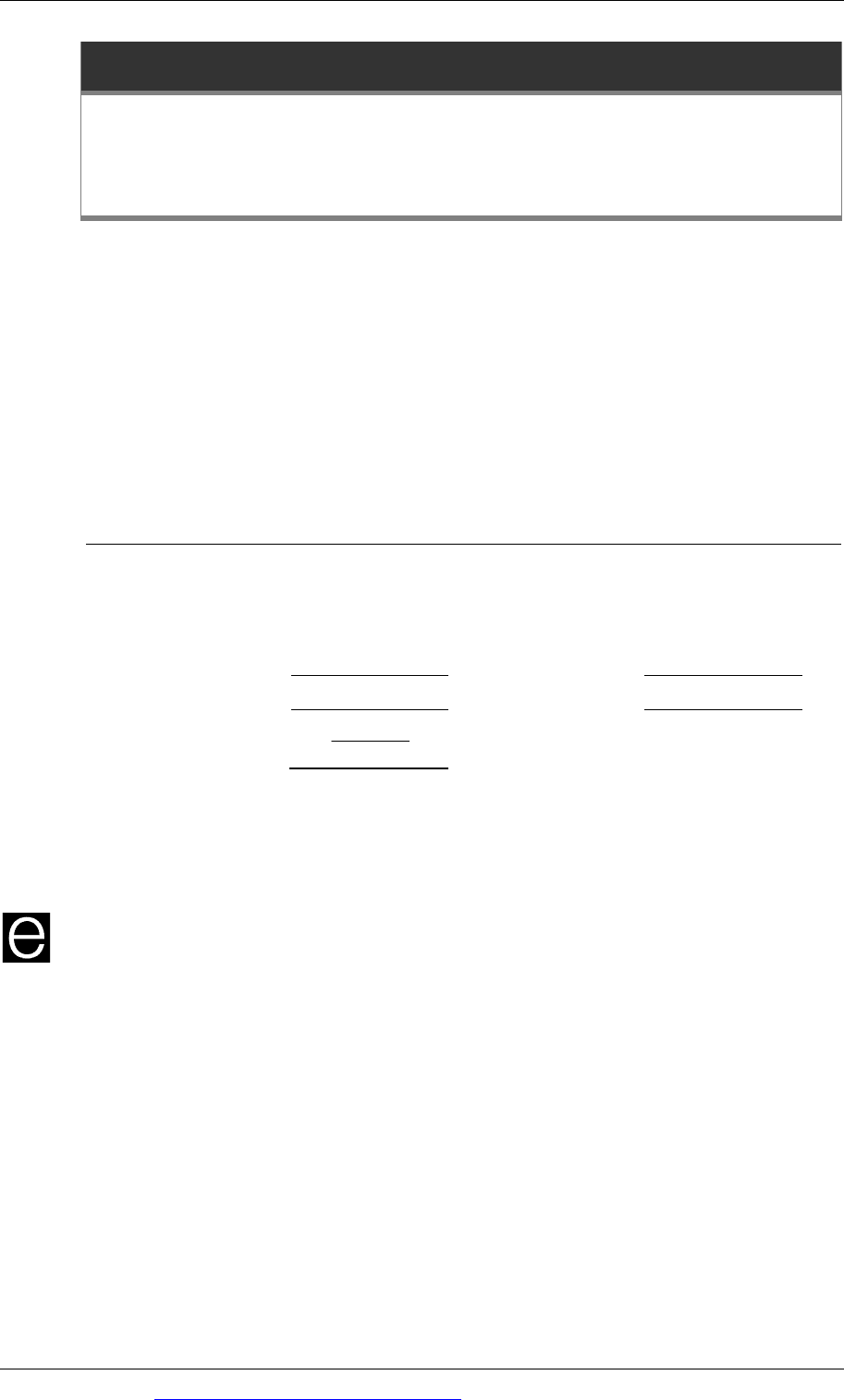ACCA F9 Financial Management - 2010 - Study text - Emile Woolf Publishing
Подождите немного. Документ загружается.


Chapter 16: Cost of capital
© EWP Go to www.emilewoolfpublishing.com for Q/As, Notes & Study Guides 285
The cash flows for calculating the cost of redeemable debt
If Method 2 is used, the cash flows used to calculate an IRR (redemption yield) are:
The current market value of the bond, excluding any interest payable in the near
future: this is a cash outflow. The yield can be calculated for $100 of bonds
(nominal value). For example if the market price is $101.50 ($101.50 per $100
nominal value of bonds), the Year 0 cash outflow is (101.50).
The annual interest payments on the bond: these are cash inflows
Tax relief on these annual interest payments: these are cash outflows (the
opposite of the interest payments) and occur either in the same year as the
interest payments or one year in arrears, depending on the assumption used
about the timing of tax payments
The redemption value of the bonds, which is often par. If the bonds are
redeemable at par, the cash inflow from the redemption of the bonds will be
100.0 in the year when the bonds are redeemed.
If Method 1 is used, the tax cash flows are ignored.
Example
The current market value of a company’s 7% loan stock is 96.25. Annual interest has
just been paid. The bonds will be redeemed at par after four years. The rate of
taxation on company profits is 30%.
Required
Calculate the after-tax cost of the bonds for the company:
(a)
assuming that these bonds will be replaced at redemption with identical bonds
(i.e. using Method 1)
(b)
using the normal method of computation, Method 2.
Answer
(a) Method 1
Year Cashflow Try8% Try10%
Discount
factor
PV
Discount
factor
PV
0 Marketvalue (96.25) 1.000 (96.25) 1.000 (96.25)
1 Interest 7.00 0.926 6.48 0.909 6.36
2 Interest 7.00 0.857 6.00 0.826 5.78
3 Interest 7.00 0.794 5.56 0.751 5.26
4 Interest 7.00 0.735 5.15 0.683 4.78
4 Redemption 100.00 0.735 73.50 0.683 68.30
NPV +0.44(5.77)

Paper F9: Financial management
286 Go to www.emilewoolfpublishing.com for Q/As, Notes & Study Guides © EWP
Using interpolation, the before-tax cost of the debt is:
8%+
0.44
0.44 + 5.77
()
× 10 − 8
()
% = 8.14%
The after-tax cost of the debt is therefore estimated as 8.14% × (100 – 70)% = 5.7%
(
Note: deciding which cost of capital to try first. If you don’t know which cost of
capital to try first, calculate the average annual net cash flow as a percentage of the
current market value. Here the total annual net cash inflows = 7 + 7 + 7 + 107 – 96.25
= 31.75 which averages 7.9375 each year. As a percentage of the market value 96.25,
this is 8.2%. So try 8% first).
(b)
Method 2
It is assumed here that tax savings on interest payments occur in the same year as
the interest payments.
Year Cashflow Try6% Try5%
Discount
factor
PV
Discount
factor
PV
0 Marketvalue (96.25) 1.000 (96.25) 1.000 (96.25)
1 Interestlesstax 4.90 0.943 4.62 0.952 4.66
2 Interestlesstax 4.90 0.890 4.36 0.907 4.44
3 Interestlesstax 4.90 0.840 4.12 0.864 4.23
4 Interestlesstax 4.90 0.792 3.88 0.823 4.03
4 Redemption 100.00 0.792 79.20 0.823 82.30
NPV(0.07) +3.41
Using interpolation, the after-tax cost of the debt is:
5%+
3.41
3.41+ 0.07
()
× 6 −5
()
% = 5.98%, say 6.0%.
If in doubt, use Method 2.
3.4 Cost of convertible debt
The cost of a convertible bond is the higher of:
the cost of the bond as a straight bond that will be redeemed at maturity, and
the IRR of the relevant cash flows assuming that the conversion of the bonds into
equity will take place in the future.
The cost of capital of the bond as a straight bond is only the actual cost of the bond if
the bonds are not converted into shares at the conversion date. The IRR of the

Chapter 16: Cost of capital
© EWP Go to www.emilewoolfpublishing.com for Q/As, Notes & Study Guides 287
relevant cash flows is the cost of the convertible bond assuming that conversion will
take place.
The relevant cash flows for calculating this yield (IRR) are:
the current market value of the bonds (Year 0 outflow)
annual interest on the bonds up to the time of conversion into equity (annual
inflows)
tax relief on the interest (annual outflows)
the expected market value of the shares, at conversion date, into which the
bonds can be converted.
Example
The current market value of a company’s 7% convertible debenture is $108.70.
Annual interest has just been paid. The debenture will be convertible into equity
shares in three years time, at a rate of 40 shares per debenture. The current ordinary
share price is $3.20 and the rate of taxation on company profits is 30%.
Required
Calculate the after-tax cost of the bonds for the company.
Year Cashflow Try 10% Try9%
DCF
factor
PV DCF
factor
PV
0 Currentmarketvalue (108.7) 1.000 (108.7) 1.000 (108.7)
1‐3 Interestlesstax 4.90 2.487 12.19 2.531 12.40
3
Valueofshareson
conversion(40x$3.2)
128.00 0.751 96.13 0.772 98.82
NPV(0.38)+2.52
Using interpolation, the after-tax cost of the debt is:
9% + [2.52/(2.52+ 0.38)] × (10 – 9)% = 9.9%.
The cost of the convertibles as a straight bond is obviously less than 9.9% (since the
market value is above par and the coupon is only 7%). The market therefore expects
the bonds to be converted into equity, and the after-tax cost is 9.9%.
Exercise 1
A company has issued 4% convertible bonds that can be converted into shares in
two years’ time at the rate of 25 shares for every $100 of bonds (nominal value). It is
expected that the share price in two years’ time will be $4.25. If the bonds are not
converted, they will be redeemed at par after four years. The yield required by
investors in these convertibles is 6%.

Paper F9: Financial management
288 Go to www.emilewoolfpublishing.com for Q/As, Notes & Study Guides © EWP
What is the value of the convertible bonds?
3.5 Cost of preference shares
For irredeemable preference shares, the cost of capital is calculated in the same
way as the cost of equity assuming a constant annual dividend, and using the
dividend valuation model.
MV
d
r =
where:
r
is the cost of the preference shares
d = the expected future annual dividend
MV is the share price ex dividend.
For
redeemable preference shares, the cost of the shares is calculated in the same
way as the pre-tax cost of irredeemable debt. (Dividend payments are not subject to
tax relief, therefore the cost of preference shares is calculated ignoring tax, just as the
cost of equity ignores tax.)

Chapter 16: Cost of capital
© EWP Go to www.emilewoolfpublishing.com for Q/As, Notes & Study Guides 289
Calculating the WACC
Method of calculating the weighted average cost of capital (WACC)
WACC and market values
WACC and book values
4 Calculating the weighted average cost of capital
(WACC)
4.1 Method of calculating the WACC
The weighted average cost of capital (WACC) is a weighted average of the (after-
tax) cost of all the sources of capital for the company. The weightings given to each
item of finance in the capital structure should be its total market value.
Source of finance Market value
×
Cost Market value × Cost
r MV × r
Equity MV
E
×
r
E
MV
E
× r
E
Preference shares MV ×
r
P
MV
P
× r
P
Debt MV
D
×
r
D
MV
D
× r
D
Total
Σ
MV
ΣMV x r
WACC =
Σ
MV x r
Σ
MV
The WACC for a company is found using the method shown above. If there is more
than one source of debt, each with a different cost, there should be a separate line in
the table for each item of debt.
Example
A company has 10 million shares each with a value of $4.20, whose cost is 7.5%. It
has $30 million of 5% bonds with a market value of 101.00 and an after-tax cost of
3.5%. It has a bank loan of $5 million whose after-tax cost is 3.2%. It also has 2
million 8% preference shares of $1 whose market price is $1.33 per share and whose
cost is 6%. Calculate the WACC.

Paper F9: Financial management
290 Go to www.emilewoolfpublishing.com for Q/As, Notes & Study Guides © EWP
Answer
Sourceof
finance
Marketvalue Cost
Marketvalue×
Cost
$million r MV×r
Equity 42.00 0.075 3.150
Preferenceshares 2.66 0.060 0.160
Bonds 30.30 0.035 1.061
Bankloan 5.00 0.032 0.160
79.96 4.531
WACC =
4.531
79.960
= 0.05667 , say 5.7%.
Formula for WACC
A formula for calculating the weighted average cost of capital is given in the
formula sheet in your examination, as follows:
WACC = V
e
e
e
K
e
+ V
d
K
d
(1 – t)
V
e
+ V
d
V
e
+ V
d
where
V
e
is the total market value of the company’s equity shares
V
d
is the total market value of the company’s debt
K
e
is the cost of equity
K
d
is the pre-tax cost of debt
t is the rate of tax on profits
This formula can only be used, however, when there is just one type of debt capital
in the capital structure and the after-tax cost of debt is calculated by applying the
factor (1 – t) to the pre-tax cost of debt.
Example
A company has 20 million shares each with a value of $6.00, whose cost is 9%. It has
debt capital with a market value of $80 million and a before-tax cost of 6%. The rate
of taxation on profits is 30%. Calculate the WACC.

Chapter 16: Cost of capital
© EWP Go to www.emilewoolfpublishing.com for Q/As, Notes & Study Guides 291
Answer
The after-tax cost of the debt capital is 6% (1 – 0.30) = 4.2%.
Using a table for calculations
:
Sourceoffinance Marketvalue Cost Marketvalue×Cost
$million r MV×r
Equity 120.00 0.090 10.80
Bonds 80.00 0.042 3.36
200.00 14.16
WACC = 14.16/200 = 7.08%
Using the formula:
WACC = 120
9%
+ 80
6%
(1 – 0.30)
200
200
= 5.4% + 1.68% = 7.08%
Both methods give the same WACC.
4.2 WACC and market values
For a company with constant annual ‘cash profits’, there is an important connection
between WACC and market value. (Note: ‘Cash profits’ are cash flows generated
from operations, before deducting interest costs.)
If we assume that annual cash profits are a constant amount in perpetuity, the total
value of a company, equity plus debt capital, is calculated as follows:
Total market value of the company =
Annual cash profits
WACC
From this formula, the following conclusions can be made:
The lower the WACC, the higher the total value of the company will be (equity +
debt capital), for any given amount of annual profits.
Similarly, the higher the WACC, the lower the total value of the company.
For example, ignoring taxation, if annual cash profits are, say, $12 million, the total
market value of the company would be:
$100 million if the WACC is 12% ($12 million/0.12)
$120 million if the WACC is 10% ($12 million/0.10)
$200 million if the WACC is 6% ($12 million/0.06).

Paper F9: Financial management
292 Go to www.emilewoolfpublishing.com for Q/As, Notes & Study Guides © EWP
The aim should therefore be to achieve a level of financial gearing that minimises
the WACC
, in order to maximise the value of the company.
Important questions in financial management are:
For each company, is there an ‘ideal’ level of gearing that minimises the WACC?
If there is, what is it?
4.3 WACC and book values
The WACC should be calculated using market values for equity, debt capital and
preference shares.
The study guide to the syllabus specifies that you should also be able to calculate a
WACC using balance sheet values (book values) for equity and debt. This is an
unusual syllabus requirement, since WACC based on book values has no meaning
and no value. The cost of equity and the cost of debt are not based on actual returns
required by investors; therefore they have no obvious significance.
WACC using book values is calculated in the same way as the calculation of WACC
using market values, with the following differences.
Instead of using the market value of equity shares, take the value of equity
shares plus reserves from the balance sheet.
Instead of using the market value of debt capital, use its nominal value.
Instead of using the cost of debt based on market values and investment yields
on debt, use the ‘coupon’ rate (nominal rate) of interest on fixed rate debt. The
current floating rate of interest should be used for variable rate debt. The cost of
debt can be converted into an after tax cost, if required, using the factor (1 – t).
Instead of using the cost of equity using the CAPM or a dividend valuation
model, you might be required to calculate the cost of equity as (annual
dividends divided by the balance sheet value of equity capital and reserves)
×
100%.
Example
Extracts from the balance sheet of a company are shown below.
Equity and reserves $m
Ordinary shares of $1 100
Reserves 500
600
Bank loan 200
8% bonds 300
1,100
The current rate of interest on the bank loan is 9%.
Annual dividends of $84 million are paid to shareholders.
What is the WACC using book values? Ignore taxation.

Chapter 16: Cost of capital
© EWP Go to www.emilewoolfpublishing.com for Q/As, Notes & Study Guides 293
Answer
The cost of the bank loan is 9%
The cost of equity is assumed to be 84/600 = 0.14 or 14%.
Sourceof
finance
Bookvalue ‘Cost’ Bookvalue×Cost
$million r MV×r
Equity 600 0.14 84
Bankloan 200 0.09 18
Bonds 300 0.08 24
1,100 126
WACC using book values = 126/1,100 = 0.1145 or 11.45%.
It must be stressed, however, that a WACC based on book values is not an accurate
measure of a company’ WACC, because cost of capital should measure yields
required by investors. Measures based on book values are not a measure of these
yields, and weightings based on book values are also unreliable.

Paper F9: Financial management
294 Go to www.emilewoolfpublishing.com for Q/As, Notes & Study Guides © EWP
Cost of capital and gearing
The traditional view of gearing and WACC
The Modigliani-Miller view: ignoring corporate taxation
The Modigliani-Miller view: allowing for corporate taxation
5 Cost of capital and gearing
For a given level of annual cash profits before interest and tax, the value of a
company (equity + debt) is maximised at the level of gearing where WACC is
lowest. This should also be the level of gearing that optimises the wealth of the
company’s equity shareholders.
The question is therefore: Is there a level of gearing where the WACC is minimised?
If WACC is minimised at a particular level of gearing a company should try to
achieve a capital structure where this minimum WACC occurs.
However, there are different theories about the relationship between WACC and
gearing. The three you need to know are:
The traditional theory of WACC and gearing
Modigliani and Miller’s theory of WACC, ignoring taxation
Modigliani and Miller’s theory of WACC, allowing for taxation.
5.1 The traditional view of gearing and WACC
The traditional view of gearing is that there is an optimum level of gearing for a
company, where WACC is minimised. This theory is based on the following
assumptions.
As gearing increases, the cost of equity rises. However, as gearing increases,
there is also a greater proportion of debt capital in the capital structure, and the
cost of debt is cheaper than the cost of equity.
As gearing increases, WACC is therefore affected by a higher cost of equity, but
a larger proportion of cheaper debt capital.
At lower levels of gearing, as gearing increases, the effect of having more debt
capital has a bigger effect on the WACC than the rising cost of equity.
Consequently the WACC falls as gearing increases.
However, after a certain level of gearing is reached, if gearing continues to
increase, the increase in the cost of equity has a greater effect on WACC than the
larger proportion of cheap debt capital. The WACC starts to rise.
The traditional view of gearing is therefore that an optimum level of gearing exists,
where WACC is minimised and the value of the company is maximised. A graph of
WACC at different levels of gearing can be drawn as a saucer-shaped or bowl-
shaped curve.
